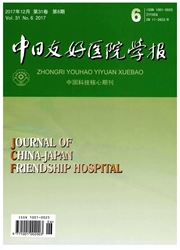

 中文摘要:
中文摘要:
目的:检测系统性红斑狼疮(SLE)患者血清中抗PUF60抗体水平,探讨该抗体阳性的SLE患者的临床和实验室特征。方法:选取我院收治的SLE患者104例和健康对照163名。采用ELISA法测定上述人群血清中抗PUF60抗体,部分抗体阳性血清采用免疫印迹法进一步验证。结果 :血清抗PUF60抗体在SLE中的阳性率为17.3%(18/104)。抗PUF60抗体阳性的SLE患者发病年龄[21(18,27)岁]低于抗体阴性组[29(20,37)岁](P=0.007),脱发的发生率[72.2%(13/18)]高于抗体阴性组[40.7%(35/86)](P〈0.05)。抗PUF60抗体阳性组中补体C4降低、外周血B1细胞数目升高的患者比例和抗ds DNA抗体、抗Sm抗体及抗SSB抗体的阳性率显著高于抗PUF60抗体阴性组(P〈0.05)。结论 :本研究首次对我国SLE患者血清中抗PUF60抗体进行检测,发现抗PUF60抗体是SLE的相关性抗体,该抗体阳性者具有独特的临床表型。
 英文摘要:
英文摘要:
Objective:To determine the sera levels and clinical significance of anti-PUF60(poly-U-binding factor 60 k Da)antibodies in patients with systemic lupus erythematosus(SLE).Methods:Sera from 104 Chinese patients with SLE and 163 healthy controls were collected.The anti-PUF60 antibodies were measured by enzyme linked immunosorbent assay.Four cases positive sera were further examined by immunoblot assays.Results:The positive rate of sera anti-PUF60 autoantibodies in patients with SLE was 17.3%(18/104).The antiPUF60-positive patients had significantly younger age [21(18,27)vs 29(20,37)years old,P=0.007]and higher incidence of alopecia [72.2%(13/18) vs 40.7%(35/86),P〈0.05]than the anti-PUF60-negative patients.Compared with anti-PUF60-negative patients,the occurrences of hypocomplementemia,elevated B1-cell subpopulations were much higher in anti-PUF60-positive patients than in anti-PUF60-negative patients(P〈0.05).Meanwhile,the positive rates of anti-ds DNA,Sm,SSB were higher in patients with positive anti-PUF60 antibodies(P〈0.05).Conclusion:We found that anti-PUF60 antibody was a new valuable SLE-associated antibody in Chinese,which related to specific clinical manifestations.
 同期刊论文项目
同期刊论文项目
 同项目期刊论文
同项目期刊论文
 期刊信息
期刊信息
